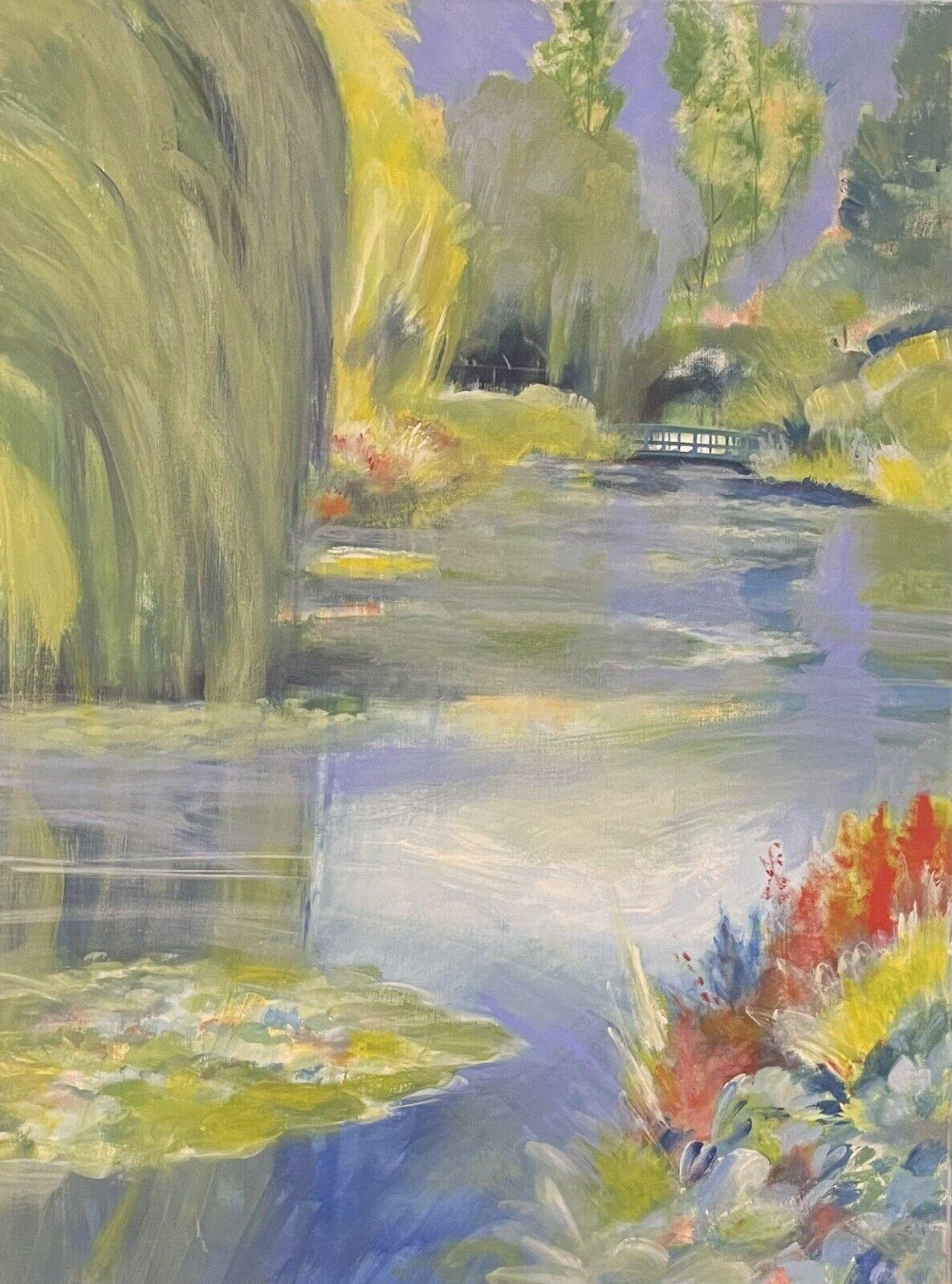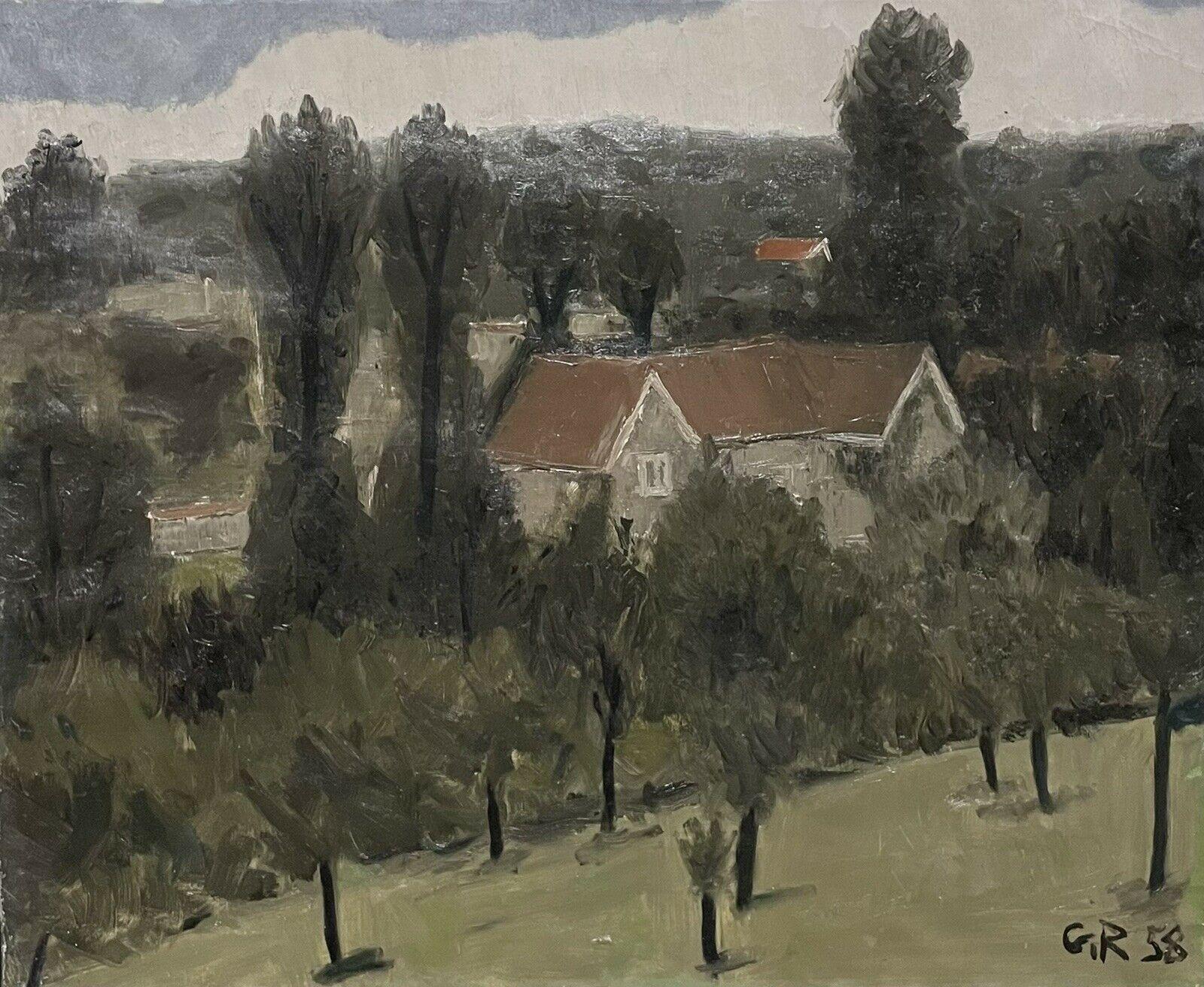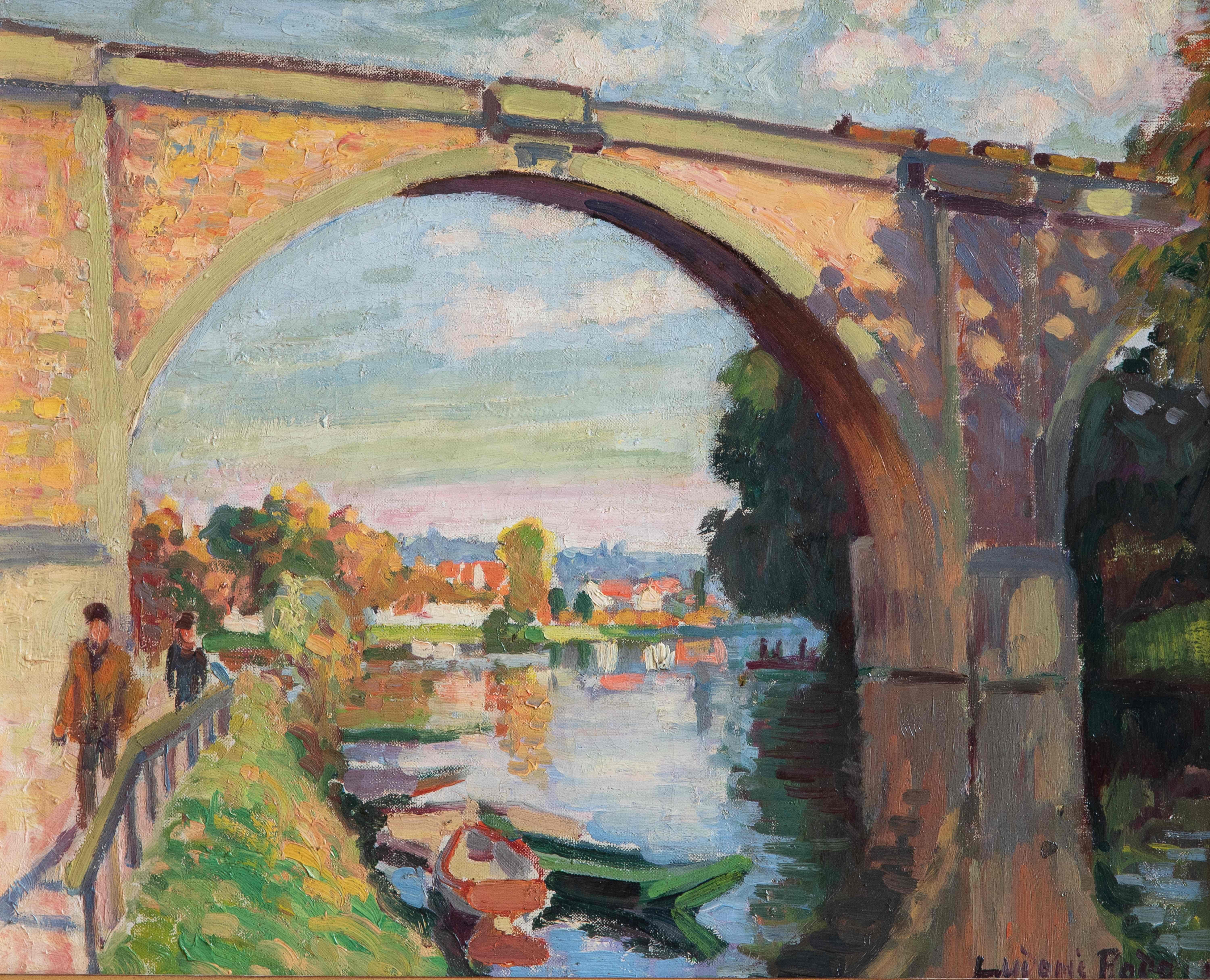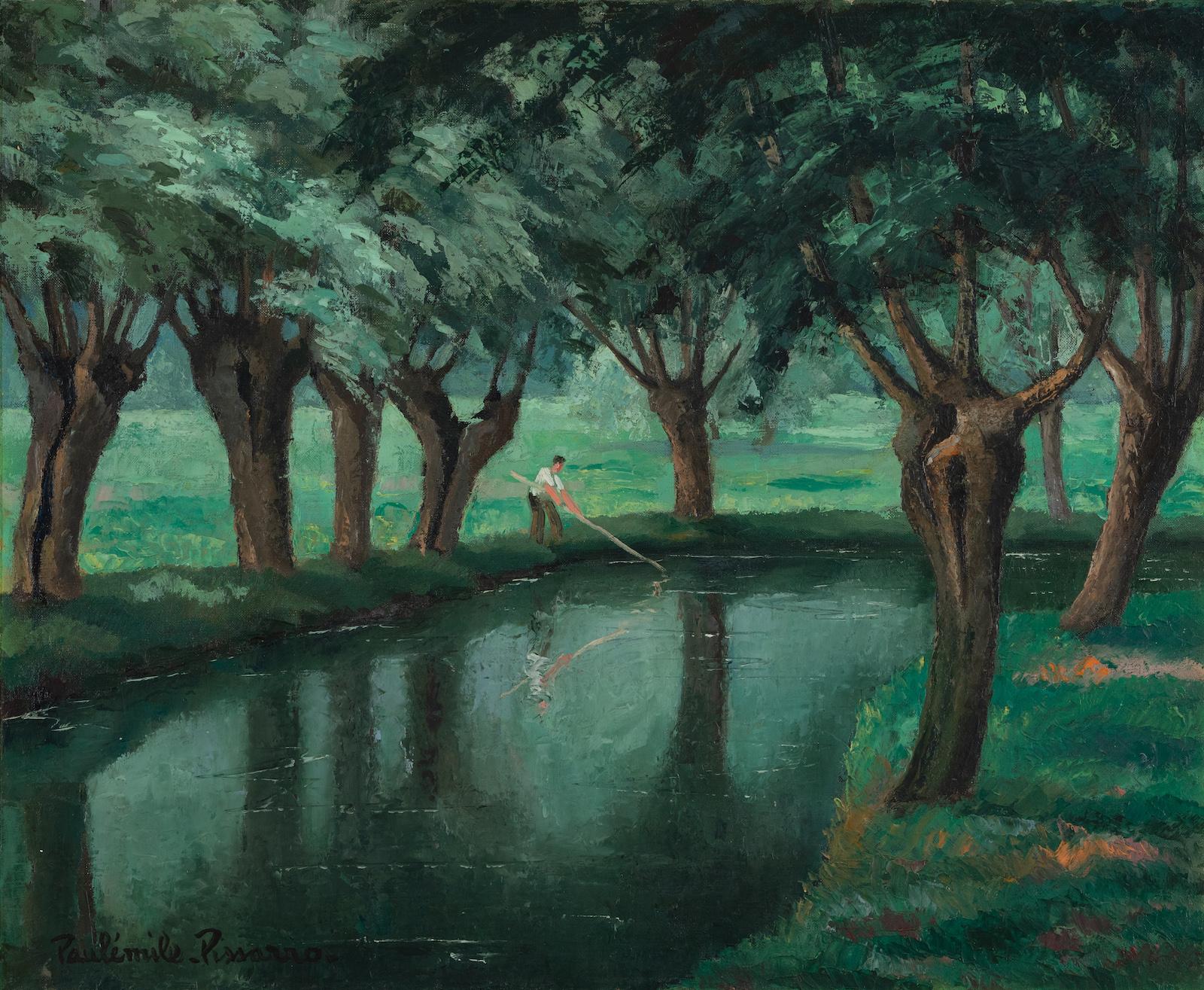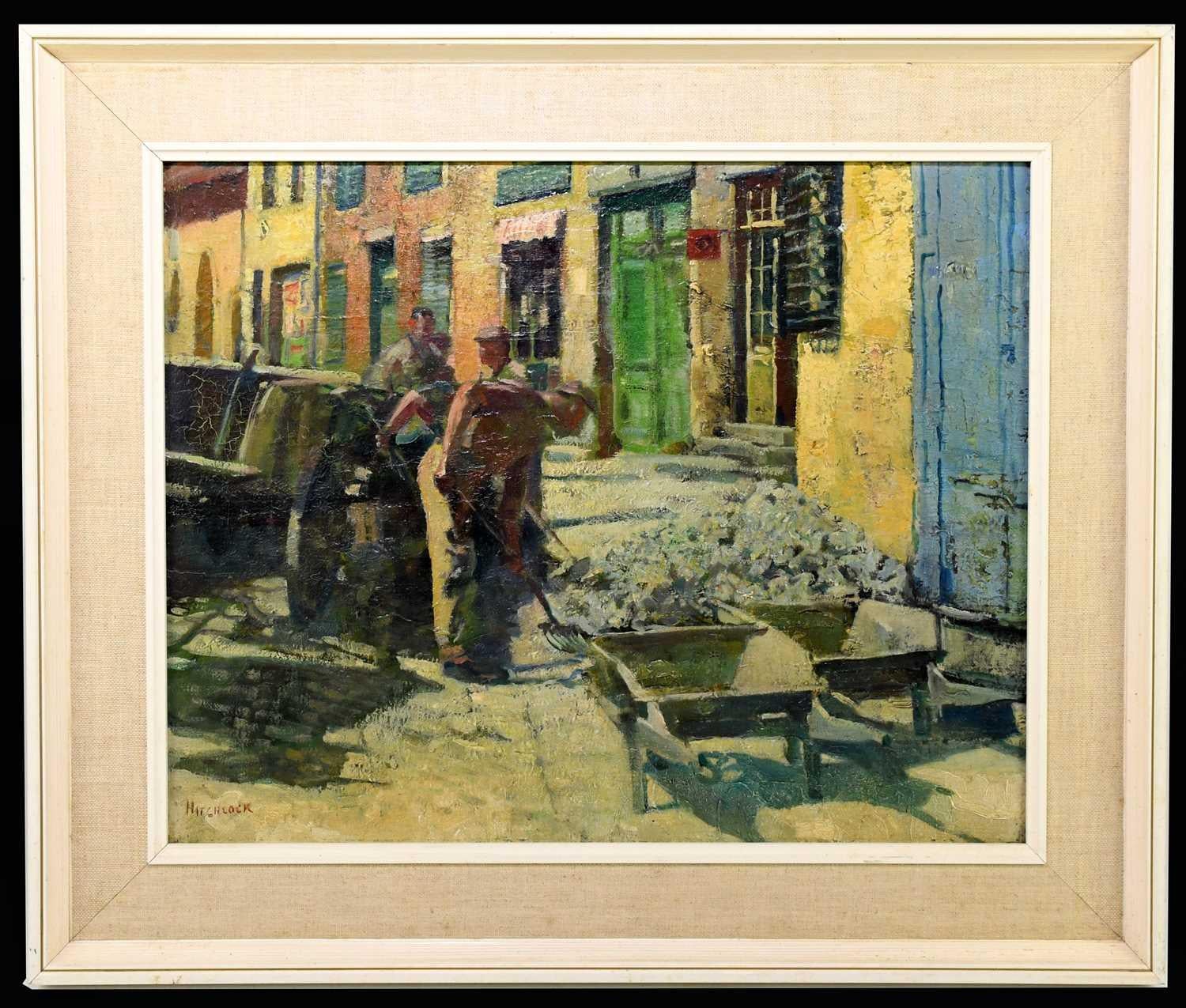Items Similar to Pont Neuf - Evening - 19th Century Oil, Riverscape at Night by A E Othon Friesz
Want more images or videos?
Request additional images or videos from the seller
1 of 9
Achille-Émile Othon FrieszPont Neuf - Evening - 19th Century Oil, Riverscape at Night by A E Othon Friesz1903
1903
About the Item
THIS WORK IS CURRENTLY ON LOAN TO THE MUSEUM OF MODERN ART IN LE HAVRE AND IS BEING EXHIBITED IN THEIR ELECTRIC NIGHTS EXHIBITION 2020
A stunning oil on original canvas by Achile-Emile Othon Friesz depicting a night time view of the Pont Neuf bridge over the Seine, Paris. The painting shows deep blues and reds - richer than those of traditional impressionist paintings - and shows the transition into Fauvism. Signed and dated 1903 lower right. Framed dimensions are 24.5 inches high by 20 inches wide.
Achille Friesz was the son of a family of sailors from Le Havre. From 1885 he often spent time in Marseilles visiting his maternal uncles. As a child he dreamed of going to sea, but from the age of 12 he developed a passion for art, and after secondary school he attended the École des Beaux-Arts in Le Havre. There, from 1896 to 1898, he studied under Charles-Marie Lhullier who had been a friend of Jongkind and whom, like Dufy and Braque, he remembered fondly throughout his life. Lhullier introduced his students to the work of Chardin, Corot, Géricault and Delacroix.
After receiving a bursary from the local authorities in 1898, he went to Paris and, while his friends Matisse, Rouault and Marquet studied under Gustave Moreau, enrolled at the École des Beaux-Arts at the studio of Léon Bonnat, where he was joined by Dufy. However, he scarcely attended the studio, preferring to go to the Louvre and make copies of the works of Clouet, Veronese, Rubens, Claude Lorraine and Delacroix. He did his military service in Paris in 1902 but continued with his art. Around this time he met Camille Pissarro and sought his advice.
As a young man he began to make frequent trips away, not necessarily travelling very far, but looking for subjects for his work, usually landscapes. Among the places he visited were the Creuse region around 1903, Antwerp in 1905, returning there with Braque in 1906, and La Ciotat, Cassis and L'Estaque in 1906-1907, again in the company of Braque. In Paris he frequently moved lodgings until 1914. He moved in with Henri Matisse at the Couvent des Oiseaux from 1905-1910, that is to say at the period when Fauvism was at its height. In 1908 he returned to his native Normandy to reimmerse himself in his early environment; he would return to the region throughout his life. He made a trip to Munich with Dufy in 1909, and visited Portugal in 1911-1912 and Belgium in 1912. In 1914 he was called up and assigned to technical services, not being demobilised until March 1919, although he did manage to maintain a certain independence. From 1914 until his death he lived in Paris at 73 Rue Notre-Dame-des-Champs, where he occupied Bouguereau's old studio. He made frequent trips to Cap-Brun near Toulon where, in 1923, he acquired a property called Les Jarres, as well as making numerous visits to Normandy and Le Havre.
In 1925 he received the highest commendation at the Carnegie Prize in Pittsburgh for Portrait of the Decorative Artist Paul Paquereau. Also in 1925, at the same time as Matisse, he was made a Chevalier of the Légion d'Honneur, rising to in Officier in 1933 and Commandeur in 1937. He was also made Commander of the Swedish order of Vasa in 1934. Throughout his life, Friesz was a teacher: from 1913 at the Académie Moderne; from 1929 at the Académie Scandinave; and from 1941 until his death at the Académie de la Grande-Chaumière.
Alongside his activity as a painter, he illustrated several works of literature, including: in 1920 Le Pacte de l'Écolier Juan by Jules Tellier; in 1924 Échelles de Soie by Jean Pédron; in 1926 Le Jardin sur l'Oronte by Maurice Barrès; in 1926 En Suivant la Seine by Gustave Coquiot; in 1929 Rouen by André Maurois; in 1931 The Song of Songs; in 1934 Poésies by Pierre de Ronsard; in 1945 Le Bouquet de la Mariée by Gabriel-Joseph Gros; in 1947 Paul et Virginie by Bernardin de St-Pierre; in 1949 Le Livre de Job by Pierre Poussard; in 1949 Petronius's Satyricon, and in 1949 a collection of 12 unpublished lithographs for Le Désert de l'Amour by François Mauriac. He also designed several pieces of decorative art: from 1906 to 1909 ceramics executed by Metthey among others; a façade for a private house in Le Havre; a china service for two for the Le Havre writer J.-G. Aubry; vases, dishes and plates; in 1912 four sets for La Lumière by Georges Duhamel, performed at the Odéon; in 1916 a screen for the Le Havre collector Léon Pédron; in 1918 panels for Pédron's dining room; in 1920 a mural entitled Children Dancing (Enfants Dansant); in 1920 Les Volières for the apartment of Vicomte Amédée de Flers; in 1935 Peace (La Paix), a Gobelins tapestry presented by France to the Palais des Nations in Geneva; in 1937 La Seine in collaboration with Dufy for the Palais de Chaillot, with each artist taking half of the river's course - From the Source to Paris by Friesz and From Paris to the Estuary by Dufy.
The Fauves were producing Fauve paintings before they knew it: it was not until the critic Louis Vauxcelles saw their work at the Salon des Indépendants in 1905 and mockingly used the word Fauve to describe it that the term was born. It is known that Vlaminck and Derain worked together and that the École de Chatou was composed of just these two artists. Friesz was living with Matisse and after his first trip to Antwerp in 1905, he returned in 1906 with Braque. In 1906-1907 Friesz and Braque went to La Ciotat to paint and there they met up with Matisse. The paintings Friesz produced in Antwerp are Fauve inasmuch as they are painted in pure colours and are more or less free of the divisionism of the Impressionists, although the draughtsmanship is fairly standard; these works include The Port, The Escaut, The Canals, The Dock with Sailing Ships and The Red Slipway. Those of Braque the following year, in particular Terrace on the Escaut, show great similarities with those Friesz painted of the same subject. Friesz was already avoiding the hardness of pure flat tints by graduating them in thin glazes, allowing the whiteness of the canvas to penetrate the transparency, a technique that came to characterise his entire Fauve period.
At La Ciotat Friesz and Braque adopted completely different Fauve styles, with Braque composing his paintings on horizontal and vertical orthogonals painted in small, regular, spaced-out touches, whereas Friesz developed his own personal rhythmical style of wide arabesques of colour in works such as The Bec-de-l'Aigle, Women Bathing and L'Estaque. Many of Friesz's Fauve works were produced in the south of France, and his Portrait of Fernand Fleuret also dates from this period.
When he returned to Normandy in 1908 the period that he described as his 'return to form' began; with compromise paintings such as Entrance to the Port of Honfleur, Côte de Grâce Landscape, The 'Bains Marie-Christine' in Le Havre and the great compositions characteristic of this period - Autumn Labours, Spring, Fisherman on a Rock and Women Bathing. His draughtsmanship retains something of the rhythm of the Fauve period, his figures following the lines of the landscape and the colour remaining clear and resonant. In 1909 he painted the Cirque Médrano series: The Trapeze Artist, The Clown and The Horsewoman. In the south of France he also painted the Olive Trees series. He made a trip to Munich with Raoul Dufy resulting in Winter in Munich. This was also the year of his first trip to Italy. Boat in a Rocky Inlet of 1910 marks one of the pivotal points between a totally rhythmic drawing style of sensual curves typical of his Fauve period and a reduced palette of muted ochres, browns and blues. From 1910 onwards, the final traces of Fauvism become less and less apparent in his work. His use of colour follows the same course, towards the transcription of reality, with broken tones, ochres and browns.
After his demobilisation, as well as in his studio in Paris, Friesz spent time in his house in Toulon, returned to Normandy and Le Havre and continued to make frequent, often local, forays in search of new subjects: in 1919 to Jura, producing the series Forests, Pine Trees, Road in the Snow and Invitation to Skate; in 1920 to Italy producing Piedmont Village, Florence Grape Pickers; in 1920 to Le Havre, producing The Étretat Cliffs, People Bathing at Étretat; in 1923 to his house in Toulon, producing View of Coudon, Women Bathing, Grape Harvesting, Jars; in 1924 he painted the Large Nude (which he exhibited at the Salon d'Automne the same year) and landscapes of Toulon; in 1928 he made a trip to Algiers, producing The Algiers Kasbah and its Phantoms; in 1931 to Annecy, producing Women Bathers by a Lake; in 1934-1935 to Dinan and St-Malo producing The Great Dinan Viaduct, The Dock with the Terre-Neuvas, After Bathing; in 1936 to Honfleur; in 1941-1944, remaining in Paris because of the war, he painted mainly still-lifes, including Studio Corner, Earthenware. In 1946 he returned to Honfleur; and in 1947 to La Rochelle producing The Port Tower, Tuna Boats, The Red Sail.
Numerically Friesz's work is dominated by landscapes but it should be remembered that throughout his career he tackled more ambitious compositions and appeared to do so with great ease. These include Boat in a Rocky Inlet of 1910 with its frolicking women bathers, Allegory of War of 1915 executed in 24 hours, Invitation to Skate of 1919, numerous paintings of Women Bathing over several periods and much later Women beside a Pond of 1944, which clearly demonstrates his attachment to Cézanne.
He exhibited at the Salon des Artistes Français from 1901 to 1903 and then at the Salon des Artistes Indépendants. From 1906 he exhibited annually at the Salon d'Automne, of which he later became a committee and jury member. In 1923 he took part in the founding of the Salon des Tuileries and became head of two of the Salon's sections. His work has been exhibited at countless group exhibitions all over the world. Among the most recent thematic exhibitions is Fauvism in Black and White. From Gauguin to Vlaminck, Fauvist Engraving and its Setting (Le Fauvisme en Noir et Blanc. De Gauguin à Vlaminck, l'Estampe des Fauves et son Environnement) at the Musée d'Art Moderne in Villeneuve d'Ascq in 2001.
He also showed his work in numerous solo exhibitions in Paris: his first in 1904 at the Galerie des Collectionneurs and another the same year at the Société des Peintres du Paris Moderne; in 1905 at the Galerie Berthe Weill; under contract at the Galerie Druet from 1907; with the Galerie Katia Granoff from 1924; and from December 1939 until his death with the Galerie Pétridès. He exhibited in Paris in other galleries than those with which he was contracted, and outside Paris he held solo exhibitions in 1913 at the Cassirer gallery, Berlin; in 1921, 1928, 1936 and 1958 in London; in 1921 and 1950 in Le Havre; in 1925 and 1929 in Brussels; in 1929 and 1938 in New York; in 1930 in Chicago; in 1938 in Zurich; and in 1948 in Lucerne and Geneva. His posthumous exhibitions and retrospectives include: a tribute in 1949 at the Salon d'Automne in Paris; a retrospective in 1950 at the Galerie Charpentier in Paris; an exhibition in 1950 in Geneva and again in 1953 at the Musée d'Art et d'Histoire; in 1950 at the Musée de Toulon; in 1950 in Marseilles; in 1951 at the Algiers museum; in 1951 at the Musée d'Honfleur; in 1956 at the Musée de Dieppe; in 1979 at the Musée de la Rochelle and the Musée de La Roche-sur-Yon; in 1989 the E. Othon Friesz, Rétrospective at the Galerie Katia Granoff, Paris; 1995, Émile Othon Friesz. Périodes Fauve et Cézannienne (1906-1920) at the Galerie Larock-Granoff in Paris.
Description:
A certificate oil authenticity from Odile Aittouarès accompanies this painting
The work will be included in the forthcoming update to the Catalogue Raisonne which is in preparation
Provenance:
Galerie Jacques Hamon, Le Havre c. 1950
- Creator:Achille-Émile Othon Friesz (1879 - 1949, French)
- Creation Year:1903
- Dimensions:Height: 18.5 in (46.99 cm)Width: 14 in (35.56 cm)
- Medium:
- Movement & Style:
- Period:
- Condition:Very good condition.
- Gallery Location:Marlow, GB
- Reference Number:
About the Seller
5.0
Platinum Seller
These expertly vetted sellers are 1stDibs' most experienced sellers and are rated highest by our customers.
Established in 2001
1stDibs seller since 2016
673 sales on 1stDibs
Typical response time: 2 hours
- ShippingRetrieving quote...Ships From: Marlow, United Kingdom
- Return PolicyA return for this item may be initiated within 3 days of delivery.
More From This SellerView All
- Le Jardin - Impressionist Landscape Oil Painting by Bernard Boutet de MonvelBy Bernard Boutet de MonvelLocated in Marlow, BuckinghamshireSigned and dated impressionist oil on canvas landscape by French painter, engraver, sculptor and fashion illustrator Bernard Boutet de Monvel. The work depicts a view of the artist's garden in Nemours, France. The house is concealed by two large, bare trees. A path runs through the neatly landscaped flower beds. Signature: Signed & dated 1906 lower left Dimensions: Framed: 27.5"x32.5" Unframed: 21"x26" Provenance: Private French collection Bernard Boutet de Monvel was the son of Louis Boutet de Monvel and first studied under his father. He went on to study under Luc-Olivier Merson and the sculptor Jean Dampt...Category
Early 1900s Impressionist Landscape Paintings
MaterialsCanvas, Oil
- Pink Roses - Neo-Impressionist Oil, Flowers in Garden by Theo van RysselbergheBy Theo van RysselbergheLocated in Marlow, BuckinghamshireA wonderful oil on paper laid on canvas circa 1905 by French neo-impressionist painter Theo Van Rysselberghe depicting a climbing rose - the pink of the flowers contrasting against the green and yellow of the leaves. Signature: Signed lower right Dimensions: Framed: 23"x23" Unframed: 17"x17" Provenance: This work is included in the Catalogue Raisonne of Theo van Rysselberghe by Ronald Feltkamp under the reference P-032 Sotheby's, New York, November 5, 1969, lot 83 Christie's, Amsterdam, June 9, 2004, lot 87, Lancz Gallery, Brussels, Private collection, United Kingdom Exhibition: Le Lavandou...Category
Early 1900s Impressionist Landscape Paintings
MaterialsCanvas, Oil, Laid Paper
- Figures in a Street - Normandy - Impressionist Figurative Oil - Stanislas LepineBy Stanislas Victor Édouard LépineLocated in Marlow, BuckinghamshireSigned figures in landscape oil on canvas circa 1860 by French impressionist painter Stanislas Lepine. The piece depicts a daytime view of a bustling street in Normandy on a cloudy day. Signature: Signed lower left and further signed and indistinctly titled on original artist's label verso Dimensions: Framed: 26"x19" Unframed: 18.5"x11.5" Provenance: Private French collection Stanislas Victor Édouard Lépine was the pupil of Corot in Paris between 1860 and 1875. His first paintings hardly attracted attention. He would perhaps have remained unknown for a long time if Count Armand Doria, struck by the feeling visible in his landscapes, had not taken him under his protection with Adolphe Félix Cals...Category
1860s Impressionist Figurative Paintings
MaterialsCanvas, Oil
- Belandre au soleil couchant - Impressionist Oil, Landscape by Henri DuhemBy Henri DuhemLocated in Marlow, BuckinghamshireSigned, titled and dated impressionist landscape oil on canvas by French painter Henri Duhem. The work depicts a barge moored on the side of the river with two men on the path on the riverbank. The sun is setting creating the most beautiful shades of pink and yellow in the sky which is reflecting in the water below. Signature: Signed lower right and titled and dated 1933 verso Dimensions: Unframed: 15"x18" This painting is not currently framed but a suitable frame can be sourced if required Provenance: Exhibited at the Salon des Tuileries - 1933 Private French collection Descendant of an old Flemish family, Henri Duhem was born in Douai on April 7, 1860. He worked as a lawyer at the Bar of the Court of Douai from 1883, he practiced at the same time his passion for drawing and watercolor. In 1887, he enrolled in Henri Harpignies' drawing course in Paris and, at the same time, befriended the painter Émile Breton...Category
1930s Impressionist Landscape Paintings
MaterialsCanvas, Oil
- Peniches sur la Seine - Impressionist Landscape Oil - Armand GuillauminBy Jean Baptiste-Armand GuillauminLocated in Marlow, BuckinghamshireSigned impressionist landscape oil on canvas by French painter Jean Baptiste Armand Guillaumin. The work depicts barges moored on the b...Category
1880s Impressionist Landscape Paintings
MaterialsCanvas, Oil
- Matinee d'Hiver a Evergnicourt - Impressionist Landcape Oil by Armand GueryBy Armand GueryLocated in Marlow, BuckinghamshireSigned and dated impressionist oil on canvas landscape by French painter Armand Guery. The work depicts a rural winter scene with snow covered haystacks to the left and the trees and...Category
Early 1900s Impressionist Landscape Paintings
MaterialsCanvas, Oil
You May Also Like
- The Garden at Giverny Huge French Contemporary Oil Painting Signed & Dated 2005Located in Cirencester, GloucestershireArtist/ School: French Impressionist artist, indistinctly signed to the reverse Title: Claude Monet's Garden at Giverny Medium: oil painting on canvas, unframed canvas: 28.75 x ...Category
21st Century and Contemporary Impressionist Landscape Paintings
MaterialsOil, Canvas
- 1950's French Post-Impressionist Signed Oil Village Houses in the Rhone ValleyLocated in Cirencester, GloucestershireArtist/ School: French Post-Impressionist artist, mid 20th century, signed with initials Title: Courpiere (Rhone Valley, France) Medium: oil painting on canvas, unframed canvas: 2...Category
Mid-20th Century Impressionist Landscape Paintings
MaterialsOil, Canvas
- Railroad Bridge over the Marne at Joinville by Ludovic-Rodo Pissarro - PaintingBy Ludovic-Rodo PissarroLocated in London, GBRailroad Bridge over the Marne at Joinville by Ludovic-Rodo Pissarro (1878-1952) Oil on canvas 33 x 41 cm (13 x 16 ¹/₈ inches) Signed lower right, Ludovic Rodo. Executed circa 1905 ...Category
Early 1900s Impressionist Landscape Paintings
MaterialsCanvas, Oil
- River landscape by Henri Epstein - Riverscene paintingLocated in London, GB*PLEASE NOTE UK BUYERS WILL ONLY PAY 5% VAT ON THIS PURCHASE. River landscape by Henri Epstein (1892-1944) Oil on canvas 55 x 81 cm (21 ⁵/₈ x 31 ⁷/₈ inches) Signed lower left H Epst...Category
1920s Impressionist Landscape Paintings
MaterialsCanvas, Oil
- Rivière Saulaie à Lyons-la-Forêt, Eure by Paulémile Pissarro - Oil paintingBy Paul Emile PissarroLocated in London, GBRivière Saulaie à Lyons-la-Forêt, Eure by Paulémile Pissarro (1884-1972) Oil on canvas 60 x 73 cm (23 ⁵/₈ x 28 ³/₄ inches) Signed lower left, Paulémile - Pissarro. Signed and titled...Category
1920s Impressionist Landscape Paintings
MaterialsCanvas, Oil
- Mid-Century, Men working on a roadway in France in the SummerLocated in Woodbury, CTTHEODORE CHARLES BASIL HITCHCOCK Mid Century or slightly earlier scene of men working on a pathway in a French Town. He was a painter and teacher who studied at Hornsey School of Art, after attending London University, his teachers being Adrian Hill and John Charles Moody...Category
1930s Impressionist Figurative Paintings
MaterialsCanvas, Oil
Recently Viewed
View AllMore Ways To Browse
Paris At Night
Chinese Antique Landscape
Death Night
Desert Night
St Pierre
Night Forest
Fauve Landscape
Oil Painting Dining Room
Early Painted Landscape Plates
Landscape Engravings Set
Tapestries 20 Century
Chinese Landscape Vase
Fauve Style Paintings
Paintings 19th Century Room In Paris
Paintings Chinese Landscape Antique
Oil Paintings 20st Century
Le Havre Paint
Painting Boats At Dock
